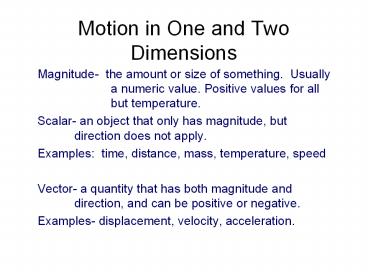Motion in One and Two Dimensions PowerPoint PPT Presentation
1 / 8
Title: Motion in One and Two Dimensions
1
Motion in One and Two Dimensions
- Magnitude- the amount or size of something.
Usually a numeric value. Positive values for
all but temperature. - Scalar- an object that only has magnitude, but
direction does not apply. - Examples time, distance, mass, temperature,
speed - Vector- a quantity that has both magnitude and
direction, and can be positive or negative. - Examples- displacement, velocity, acceleration.
2
- Distance the measure of how far objects
- d, x, y or locations are spaced from
each other Unit meters Scalar - Displacement the measure of change in distance
- (x-x1), Dx from a starting point. Unit meters
- Ex 1 lap around the track is a distance
- of 400m, but a displacement of 0.
- Vector Can be negative!
3
- Vectors can be added and subtracted.
- If two vectors point in the same direction, they
will add together to form a larger vector.
(Largest sum) - If two vectors point in opposite directions,
they subtract, with the bigger vector indicating
the direction of the result. (Smallest sum) - EX Vectors 6m and 5m. Same direction, sum is
11m. Opposite directions, 1m.
4
- Resultant the final vector that represents
- the combination of a series of
- vectors.
- Ex If vectors are at right angles, Use
Pythagorean Thm to find Resultant. - Components the x and y vectors that add
- together to form the resultant.
- EX Vector length 10, at 300, find the
- x and y components. (draw a right triangle)
5
- Trig functions- sine, cosine, tangent are useful
to resolve the vectors into components, and to
solve for missing angle. (Use only with right
triangles) - SOH- CAH- TOA
- Sine the ratio of the side opposite the angle,
and the hypotenuse. - (Sine q Opposite/Hypotenuse)
- Cosine the ratio of the side adjacent the
- angle, and the hypotenuse.
- (Cosine q Adjacent/ Hypotenuse)
6
- Tangent the ratio of the side opposite the
- angle to the side adjacent to the
- angle. (Useful in finding missing
- angle measures)
- (Tangent q Opposite / Adjacent)
- Example 1 Find the x and y components of a
velocity that is 25 m/s at 400 to the horizontal) - Example 2 A hill is 80m long, and 15m high.
What is the angle of the slope?
7
- Speed the measure of how fast something is
- v, traveling. Average speed is the speed v
x/t that we calculate from start to finish.
Direction does not matter, only how fast.
Scalar Units m/s - Velocity the change in displacement over time.
- v, velocity is a vector, the direction is
- V (x-x1)/t important. You can have a negative
- velocity. Units m/s Vector
- Instantaneous the velocity at a specific instant
in time. - Velocity vf v1 at
- vf
8
- Acceleration the rate at which the velocity
changes - a, m/s2 over time. A negative acceleration can
- indicate an object slowing down, this is
- often called deceleration. If the velocity
- a (v-v1)/t does not change, the acceleration is
0. - Kinematic equations
- 1st equation v v1 at
- 2nd equation x x1 v1t ½ at2
- 3rd equation v2 v02 2 a(x-x0)

